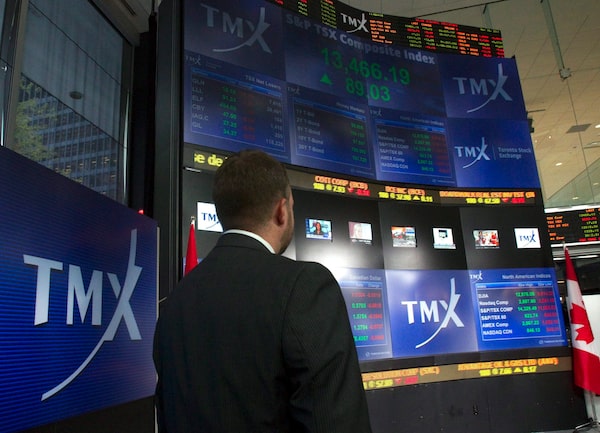
The universe of neglected stocks that represent potentially undiscovered value is surprisingly large, writes Robert Tattersall.Frank Gunn/The Canadian Press
This fall marks 50 years since I began my investment career as a portfolio manager in Canada. In September, 1971, I was hired as an investment analyst at Confederation Life Insurance Co. at a princely annual salary of $8,500 and was issued a slide rule to calculate ratios and percentages. We did have an electronic calculator: It was as large as a microwave oven and you had to book it in advance for a 30-minute slot. Pension funds at that time were limited to a foreign content of 10 per cent of total assets, so most funds held a couple of large-cap U.S. stocks in industries not represented in Canada, such as pharmaceuticals or technology. Investment updates on these companies largely originated with The Wall Street Journal, which arrived in Toronto by mail the following day.
In retrospect, there were threatening clouds on the horizon for the investment industry: Harry Markowitz had published Portfolio Selection: Efficient Diversification of Investments, his seminal 1959 book on efficient markets, but it wasn’t until 1975 that Vanguard Group founder John Bogle introduced his first index fund. There were also periods of inflated stock prices long before the tech bubble of the late nineties. In the early seventies, many U.S. money managers were great enthusiasts of the Nifty Fifty. This group of “one decision stocks” were so called because once you bought them, you never had to decide when to sell them, no matter the price. Some of them are still around today and thriving: McDonald’s Corp. , Walt Disney Co. , Procter & Gamble Co. Some still exist in name only as a shadow of their former glory: Polaroid Corp., Eastman Kodak Co. Some are no longer around: Levitz Furniture and National Student Marketing Corp.
Why am I indulging in this recap of a period before many online investors were even born? Because in those days of rudimentary analysis of sparse data points, it was plausible to believe that a diligent individual investor could identify and research out-of-favour stocks and outperform the overall market. Today, in contrast, sell-side analysts refresh their spreadsheets as soon as quarterly earnings are released and revise target prices instantly. Every investor with a subscription to The Globe and Mail has access to these revisions within a day and stock prices adjust accordingly. How can an individual investor devoting a few hours a week to investment research expect consistently to outperform the market in this environment of information overload?
The short answer is that professional money managers typically do not outperform the market after transaction costs and adjusted for risk, so individual investors with far fewer resources should face reality: Place the bulk of your equity exposure in low-fee index funds or exchange-traded funds except when you can clearly articulate some proprietary insight. In fact, even Ben Graham, the high priest of value investing, conceded toward the end of his career in 1976 that the average investor was best served by a broadly diversified portfolio of mainstream stocks rather than individual stock picking.
Assuming that the core of your equity exposure is prudently invested in passive portfolios, where might you develop some proprietary insight for the remaining investments? It certainly won’t be among the biggest market cap stocks on the Toronto Stock Exchange, such as Shopify Inc. , or the major chartered banks, since they are followed by multiple sell-side analysts. Fortunately, the universe of neglected stocks that represent potentially undiscovered value is surprisingly large. These companies are too small to be of interest to institutional investors, so there isn’t much sell-side research, which means you will have to do your own. This is, in fact, your edge: To be your own client and do your own research is a huge competitive advantage over the professionals who have to worry about quarterly performance. Patience and a streak of contrarianism are essential attributes of value investing and these are tough to sustain in organizations dominated by the marketing department.
As mentioned, the universe of stocks ripe for your analysis is surprisingly large if we make a few reasonable assumptions. Nowadays a small institutional investor manages about $1-billion of assets, so a meaningful 5 per cent portfolio position will be $50-million. There are inconvenient reporting requirements if an investor owns more than 10 per cent of the shares outstanding, so to avoid this burden the manager’s interest will likely be confined to stocks with a market cap of $500-million of more.
Turning to the TSX, there are 1,725 companies listed with a total market capitalization approaching $4-trillion. The average market cap is a hefty $2.3-billion, but the median market cap is only $173-million. In other words, half of the stocks listed on the TSX are below $173-million: No wonder many of them are considering going private or are takeover candidates. When all the listed stocks are ranked by decreasing market cap, the break point of $500-million from the previous paragraph occurs at number 578, leaving 1,147 companies below the threshold for active institutional interest. More than 700 of these companies are ETFs, mainly at the lower end of the market cap range. If they don’t gain traction soon, investors should be aware that the sponsor will likely merge or liquidate them.
The remaining universe of about 400 stocks is where the individual investor will find a competitive edge after screening for value attributes that meet his or her investment style.
Not all of these 400 stocks are bargains, of course, and many of them have a smattering of institutional holders, but the potential for wider recognition – to be reflected, one hopes, in a rising stock price – represents opportunity for individual investors who are patient and do their own research. Paradoxically, in a market dominated by big money management pools, an edge still remains for a few individuals.
Robert Tattersall, CFA, is co-founder of the Saxon family of mutual funds and the retired chief investment officer of Mackenzie Investments.
Be smart with your money. Get the latest investing insights delivered right to your inbox three times a week, with the Globe Investor newsletter. Sign up today.
 Robert Tattersall
Robert Tattersall